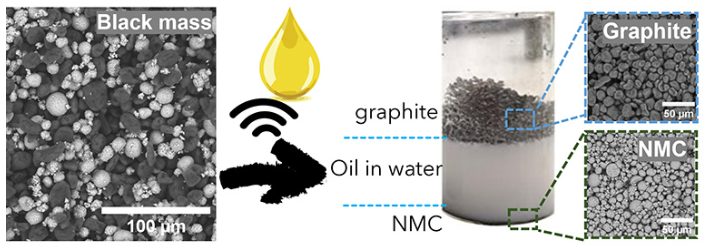Reviewed by Lexie CornerFeb 25 2025
Scientists from the University of Leicester have developed a sustainable method for extracting valuable metals from used battery waste. Led by Professor Andy Abbott and Dr. Jake Yang as part of the Faraday Institution's ReLiB project, the technique utilizes nanoemulsions of water and cooking oil to recover battery-grade metal oxides from crushed batteries. This innovative approach presents a promising solution for recycling valuable materials.
 Under a microscope, the valuable metal oxide can be seen as white spheres, whereas the black spheres are graphite. The nanoemulsion enables the graphite to float while the metal oxide sinks. Image Credit: University of Leicester
Under a microscope, the valuable metal oxide can be seen as white spheres, whereas the black spheres are graphite. The nanoemulsion enables the graphite to float while the metal oxide sinks. Image Credit: University of Leicester
Within minutes of operating at room temperature, the patent-pending technology allows for the direct purification of lithium-ion battery black mass, a mixture of anode, cathode, and other low-value materials.
Since billions of these batteries are used globally in electronics and electric vehicles, this recycling method could become more affordable and environmentally friendly, supporting the transition to greener technologies.
While water and oil do not mix without the addition of soap, studies have shown that ultrasound can generate oil nanodroplets that remain stable for weeks. It has been discovered that these oil nanodroplets can purify battery waste, referred to as "black mass," which contains valuable lithium, nickel, and cobalt metal oxides (NMC) along with a mixture of carbon (graphite).
The valuable, hydrophilic lithium metal oxides are unaffected by the oil nanodroplets, which adhere to the surface of the carbon, serving as a "glue" to bind the hydrophobic graphite particles together. This results in large oil-graphite conglomerates that float on water, from which pure metal oxides can be easily skimmed off.
Current recycling methods use concentrated corrosive acids to remove valuable battery-grade metal oxides, which are then treated with furnace heat to burn off unwanted graphite, increasing the CO2 footprint of the EV value chain.
The emulsion technique developed at the University of Leicester enables short-loop recycling of lithium-ion batteries.
Unlike pyro/hydrometallurgical methods, this process preserves the battery-grade crystalline structure of the recovered materials, allowing for their direct remanufacturing into new battery cells. This approach could make the battery supply chain more affordable and sustainable.
This quick, simple, and inexpensive method could revolutionize how batteries are recycled at scale. We now hope to work with a variety of stakeholders to scale up this technology and create a circular economy for lithium-ion batteries.
Dr. Jake Yang, Professor, School of Chemistry, University of Leicester
One challenge of the electric revolution is the difficulty in recycling large quantities of batteries efficiently and sustainably as they reach the end of their useful lives.
A sustainable future for battery use in energy storage and electric vehicles depends on an economically viable and environmentally friendly recycling process. With around 10 billion mobile phones, laptops, and tablets in use worldwide, and an estimated 40 million electric vehicles (EVs) powered by lithium-ion batteries, there is a significant need for recycling. However, due to a lack of regulations, lithium-ion battery packs are not designed for recycling.
In a project funded by InnovateUK, ReBlend, in collaboration with the Universities of Leicester and Birmingham, is working to combine several technologies developed under the ReLiB project. A pilot line is being created to process tens of kilograms of black mass per hour, demonstrating that this short-loop reprocessing can economically supply battery-grade material for new cells.
The ReLiB project is one of the Faraday Institution’s flagship projects developing innovative technology to capture value and retain scarce resources in the circular economy of battery manufacture and recycling. This work offers a promising route for short-loop recycling of lithium-ion batteries at scale.
Martin Freer, Professor and Chief Executive Officer, Faraday Institution
Journal Reference:
Lei, C., et al. (2025) Using Ultrasonic Oil-Water Nano-Emulsions to Purify Lithium-Ion Battery Black Mass. RSC Sustainability. doi.org/10.1039/d4su00771a.